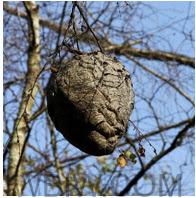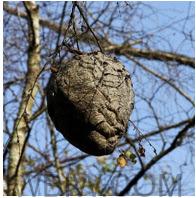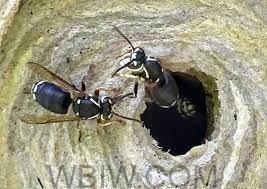
INDIANA – Ever seen a giant hornet’s nest hanging in a tree branch in winter? Are the hornets still in their nest? The answer is no the old hive, as impressive and intimidating as it is, is deserted. and now is a good time to remove it.

spring, a bald-faced hornet queen emerges from her winter palace among dead leaves on the ground. She finds a suitable place for her new home and makes a small hive from wood pulp and saliva. Having mated the previous fall, she lays her first batch of eggs for the new year. These eggs hatch and grow. These adults are now the workers. The workers will hunt, forage for food, build and guard the nest, and take care of the eggs and larvae that the queen has been producing. The queen’s only responsibility now is to lay eggs to produce more workers. As the eggs hatch and mature, the hive grows in population as well as size. By the end of summer, the nest can be as large as 14 inches in diameter by 24 inches in length and house up to 400 hornets.

Bald-faced hornets can be very aggressive if they or their home are threatened. They can also sting multiple times with no harm to themselves. Luckily for people, it’s difficult to unintentionally upset them. They build their nests high in trees at the end of the branches. The nest has been there all summer.
Bald-faced hornets are beneficial. They hunt and feed horseflies and deer flies to their young – a LOT of flies. The workers eat nectar. While they aren’t exceptional pollinators, they do transfer pollen between flowers.

At the end of summer, the queen produces two special types of eggs, fertilized and unfertilized. The fertilized eggs are potential new queens. The unfertilized eggs become males. When this brood matures, they leave the hive and mate. Their departure signals the death of the hive. All the workers die as temperatures drop, and the queen abandons the nest. She, as well as the new queens, will “hibernate” in leaf debris. The males die. It all starts over in the spring.
Source: Jackie Horn, Indiana Master Naturalist program.



